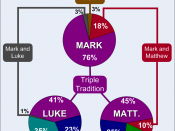The Synoptic Gospels There is no real solution to the synoptic problem. What is the synoptic problem? "The synoptic problem is the existence of which was practically unknown to the ancient ecclesiastical writers as defined in the Catholic encyclopedia"� (Synoptics). "These gospels recall the same events of Jesus' life in the same order of succession and in phrases that range from the similar to the identical"� (Synoptics).
"To grasp the complexity of the problem, one must view the synoptic fact in detail, considering the subject matter, the order of events, and the vocabulary and syntax"� (Synoptics). Mark, which is the shortest of the gospels, contains 6,661 verses, Matthew contains 1,068, and Luke contains 1,149 verses. One major difference in the three gospels is that Matthew and Luke have about 235 verses in common which are not found in Mark. Also, each evangelist has a few verses in their own gospels that the other two do not have in their gospels.
"The framework of the public ministry is identical in these Gospels: the imprisonment of the Baptist; ministry in Galilee; a journey south to Judea; a brief ministry there followed by the Passion (Synoptics).
The author of the Gospel According to Matthew is believed to be the apostle Matthew, but there is also another theory that the author of Matthew is anonymous. One major source of Matthew was the evangelist Mark. Also, Matthew had his own unique source which was called Q (from Quelle, German for "source"�) this was his second source.
Matthew arranged his gospel around five discourses of Jesus Christ. These five discourses are commonly known as the five fold division of Matthew's gospel. "In the fourth discourse tells of Jesus' baptism by John the Baptist, his temptation in the desert, and the beginning of his public ministry"� (...


